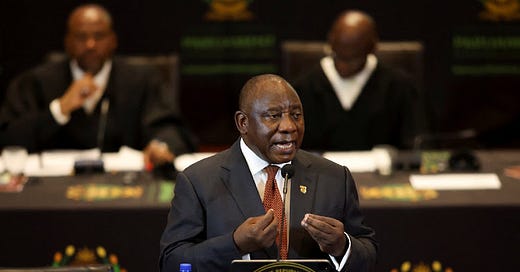The cost of resilience
In this year’s State of the Nation Address, President Cyril Ramaphosa said that what defines the essence of South Africans is “hope and resilience”.
“It is this hope that sustained us during the struggle for freedom…” he said.
This is not the first time the resilience narrative has been used by the first citizen in his addresses.
In a Freedom Day celebration keynote address in April 2022, Ramaphosa lauded South Africans for being a “resilient nation” that would “overcome the challenges it was faced with”.
A couple of months later in an address related to the lifting of COVID-19 regulations, he once again praised the “resilience of South Africans and bravery of frontline workers” during the height of the pandemic.
The President’s resilience narrative is flawed
The problem with this narrative is that it doesn’t achieve what I think the President and his communications team think it achieves. Which is to inspire South Africans into believing that we are made of some special material, capable of withstanding any and all adversity. You can knock us down seven times, we’ll get up eight.
Sadly, this isn’t the feeling it evokes in us anymore and there are two reasons for this.
Firstly, the concept of resilient countries refers to a country’s “bouncebackability”. A country’s ability to take knocks but bounce back each time. The State Resilience Index (SRI) defines resilience as “the extent to which a country can prepare, manage, and recover from a crisis, relative to the severity of that crisis”.
It ranks Norway as the most resilient country in the world, with an SRI score of 8.6 out of 10. The least resilient country, according to the SRI is Yemen, with a score of 2.9. South Africa hovers somewhere in the middle with a score of 5.7.
The SRI score is an aggregated number across the following measurement pillars:
Inclusion,
Social cohesion,
State capacity,
Individual capabilities,
Environment and ecology,
Economy,
and Civic space.
When compared to our BRICS counterparts, South Africa is the second-least resilient country within this group after India which scored 5.2.
These scores might not seem that bad relative to Norway’s whopping 8.6 but a key consideration with these scores is that they are measured on criteria that are controlled mainly by the government and are not reliant on external influences. Some of these include the inclusion of young people within the economic system, government effectiveness and good public healthcare.
Most of our problems are self-inflicted
In South Africa’s case, many of the shocks we are currently forced to deal with are self-inflicted faux pas by our inept government.
It is not some external force, although Gwede might disagree, that led us into a path of darkness with Eskom. It is not some Western “third-hand” that has made us a country with one of the highest youth unemployment rates in the world, with 61% (Stats SA, Q4 2022) of people between the ages of 15 and 24 years unable to find employment.
These are results of poor policy and managerial decisions by both government and leaders of State Owned Enterprises (SOEs).
The ANC has also failed to industrialise and modernise our economy so that it can provide sufficient employment and job security for the black, unemployed majority.
The Afrikaners built Eskom, Spoornet and Sasol in their first 30 years of Apartheid to address the unemployment problem for white folks. What can we proudly point to, that the ANC government has built in their first 30 years of democracy, to ensure job security?
South Africans are just tired of the BS
The second reason the resilience argument no longer holds water is because folks are simply gatvol. People are tired of complaining and lamenting the same things at the dinner table. They are tired of hearing empty promises and slogans that amount to naught.
If I could attempt to capture the country’s emotional disposition right now, I would use two words: “Necessary optimism”.
Folks remain optimistic not because they truly are, but because it’s necessary for them to survive. They remain hopeful that things will get better because it’s that faith that wakes them up in the morning.
It’s this necessary optimism that helps us contend with the insanely high cost of living, the rampant corruption, the incorrigible violence and the sheer despondency that reverberates throughout the country.
A despondency our political elite is either completely blind to or simply refuses to see because they’d rather believe in a pliant and “resilient” population that will constantly take the bullshit that’s handed to them and mould itself to the tune of the ANC.
We should be resilient enough to ste(e)l power away from the ANC
Ironically, South Africa is one of the largest exporters of steel in the world. Trading mainly with China and the U.S and contributing billions of rands into our GDP.
Steel is known for being a tough, hard, malleable and dare I say “resilient” material. It is preferred by car manufacturers because of these properties. It is also relatively affordable, compared to other materials.
I sometimes wonder if the ANC thinks, like Steel, South Africans can be banged up as many times as it wishes and we will remain as resilient as we were before.
It’s also worth noting that steel is also used to make deadly weapons like swords, knives and guns.
How serendipitous it would be if South Africans used their so-called “resilience” as a weapon to bring an end to the ANC’s palliative care. And help the glorious movement draw its last breath, once and for all.




